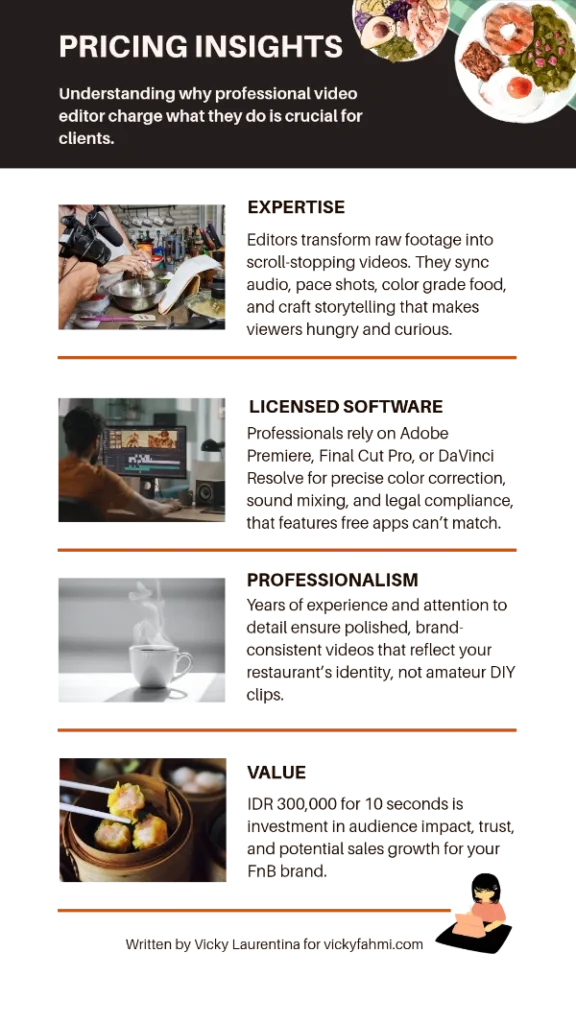Paying IDR 300,000 for just 10 seconds of a professionally edited video sounds like highway robbery to many restaurant owners. I get it. Most F&B entrepreneurs are accustomed to using iMovie or Canva, creating Instagram Stories as if it’s no big deal.
But professional editing is more like cooking a tom yam from scratch, rather than microwaving leftovers. Same ingredients, completely different outcome.
I still remember the look on a café owner’s face last year when I mentioned the cost for her menu showcase video. Her eyes went wide, like she’d just seen her weekly coffee bean budget evaporate.
She’d been happily editing on her phone, thinking scaling up was just as easy. “Can’t you just slap on some music and call it done?” she asked, genuinely baffled.
That moment stuck with me because it highlights a common trap. FnB owners admire the final video, sleek shots of siomay, and golden-brown noodles. They even rewind the scene of steam rising from a bakpao, multiple times.
But they don’t see the invisible work that makes it happen. This article peels back the curtain on what beginners rely on, and why hiring a professional actually saves time, stress, and sales.
Editing isn’t a Drag-and-Drop
On the surface, free apps make video editing look as easy as spreading butter on toast. But for beginners, it isn’t. I’ve seen restaurant owners download CapCut, spend an hour editing clips, and end up with something that could pass for a high school project.
Even “simple” tasks can spiral into hours of frustration. Syncing audio to video, removing kitchen background noise, or figuring out why the exported clip looks blurry can turn a “10-minute task” into a whole afternoon meltdown.
[Ever tried timing a simmering satay skewer to music? It’s trickier than it sounds.]
Professional editors, on the other hand, aren’t just moving clips. They layer audio, balance sound so your sizzling steak doesn’t overpower the voiceover. They also do the colour grade so that your tom yam looks rich and mouthwatering instead of muddy.
And here’s the kicker: they tell a story.
A pro knows the first three seconds decide whether viewers scroll past or stop drooling. They pace shots, lingering on steam rising from bakpao, then cutting quickly between prep shots to build energy. They end with a call-to-action that feels natural rather than forced.
Paying IDR 300,000 for 10 seconds? You’re not paying for button-clicking. You’re buying expertise that makes your audience hungry, curious, and ready to visit your restaurant.
Where Beginners Start and Why It’s Okay
Everyone starts somewhere. Many FnB owners try DIY first, by iMovie, Filmora, Canva, CapCut, or whatever.
And there’s nothing wrong with that. These tools are excellent for practice, testing ideas, or making simple social media posts. Want to show today’s special in a Story? CapCut can handle it fine.
I’ve watched a warung owner spend weeks creating content on Canva templates. Each clip looked decent, but together, they were impressive.
But a chaotic mess sometimes happened. I can find inconsistent fonts, clashing colours, and audio levels jumping around. His brand looked scattered instead of professional.
[It’s like serving fried noodles in mismatched plates. Edible, but not Instagram-worthy.]
Once you want polished, brand-consistent videos that actually drive orders, free tools hit a wall.
Professionals use Adobe Premiere, Final Cut Pro, or DaVinci Resolve. These are software that gives them control over colour, sound, pacing, and branding. That’s why YouTubers graduate from beginner apps once their channels grow: the difference is impossible to ignore.
Why Professionals Charge What They Do
So why can a 2-minute video cost a million rupiah? Here’s the breakdown:
When you add it up, IDR 300,000 for 10 seconds isn’t “too much.” You’re paying for skill, equipment, compliance, and audience impact. It is all the invisible ingredients that make your food look irresistible on screen.
Your Investment Returns
Yes, spending hundreds of thousands of rupiahs on a short video might make you wince. But think of it as investing in trust, creativity, and revenue.
I’ve seen restaurants double their delivery orders after professional videos went viral on Instagram. Suddenly, the cost feels tiny compared to the sales and loyal customers gained.
The real question isn’t whether you can afford professional editing. It’s whether you can afford to look amateur while competitors invest in content that converts. [Because nothing kills appetite faster than a shaky, pixelated video of your signature dish.]
If you publish your video on Instagram Story, remember to put a link to your website as an External Tap Link. Want to see exactly how many clicks that link gets and continue to your site? Check Website Traffic Easily with Link Tracking, it shows how to use GA4 to trace visitor paths and internal link clicks.

I am a blogger who love making content about planning and optimizing contents. Follow me in my Linked In and Instagram below.


Kalau mempertimbangkan biaya legal software yang dipakai bakal lebih mahal lagi. 😀
Hak intelektual kan memang mahal, Na 🙂